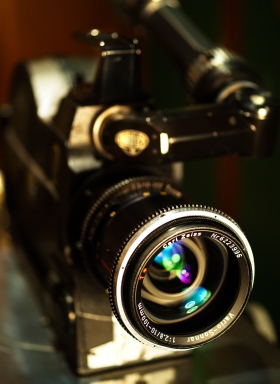Filmmaker

“Every separate sector of artistic creations,” wrote Mr. Hubbard, “has its own basic rules.” By way of example, he cited writing and painting but was particularly addressing members of the cinematographic unit he had established for the production of Scientology training films. His involvement in the field says much about the man. Although he had only informally stood behind the camera through his Hollywood days in the 1930s, by the spring of 1979 there was literally no aspect of the subject he had not studied. In evidence thereof stand eleven basic texts on the subject he drafted through the course of training film crews in Southern California.
These texts represent a clean distillation of the filmmaking process and the fundamentals of lighting, set design, editing, costumes and more. Of special note are Mr. Hubbard’s writings on acting—a field that, because it mirrors life itself, obviously intrigued him. In particular, he objected to psychology’s intrusion into the art as advocated by the Stanislavsky Method and the popular notion that the actor must “graft” his own psychological suffering onto a role with what has been perplexingly described as “a free flow of psychic energy from [the] unconscious.” Regardless of meaning, it is a long and emotionally painful process. To the writer and real actor, Mr. Hubbard declared, such methods were disastrous and, in fact, “directly contrary to the role of an artist.”
His solution was a series of eighteen instructional essays on the art of acting. All told, those essays comprise a wholly new statement on performance and revolve around the idea that an actor is one who simply conceives how his character would be—how he would walk, speak, gesture—and molds his role accordingly. Subsequent notes on the subject further defined the use of expression, diction, gestures—and very importantly—the employment of L. Ron Hubbard’s discovery of the Emotional Tone Scale, which delineated the full range of 59 emotions a being can assume.
Drawing upon his many years of experience in radio and recording—from his work as a radio performer in the 1930s to his hands-on recording of filmed dialogue and live mixing of musical performances—Mr. Hubbard’s recommendations relating to sound recording are no less significant. In the main, he declared, the field was rife with conflicting opinions and uncodified data. Indeed, he wrote, “There are no textbooks concerning the operator side of the field of sound recording, mixing and transferring.” Consequently, “I have undertaken to make available, where needed, precise and useful data on the subject of operation of sound equipment.” Today, it is no exaggeration to describe the final implementation of L. Ron Hubbard’s discoveries and technology on sound recording, mixing, copying and transferring as unmatched in terms of care and quality. This sound technology, dubbed Clearsound and exclusively utilized by the Church of Scientology’s Golden Era Productions, has led to an excellence in recording and reproduction that surpasses virtually all industry standards.
Moreover and all told, the thousand-plus pages of Mr. Hubbard’s instructional materials on the filmmaking process have thus far proven instrumental in the production of well over 2,000 educational films, documentaries and award-winning public service announcements. In that regard, there now stands an entire body of filmic work bearing the stamp of L. Ron Hubbard and reflecting what has legitimately been described as the single most definitive statement on the making of memorable films.

The L. Ron Hubbard Film Room with displays of his cinematographic, audio recording and mixing equipment. Also on display are his classic shooting scripts from Hollywood’s Golden Age.

